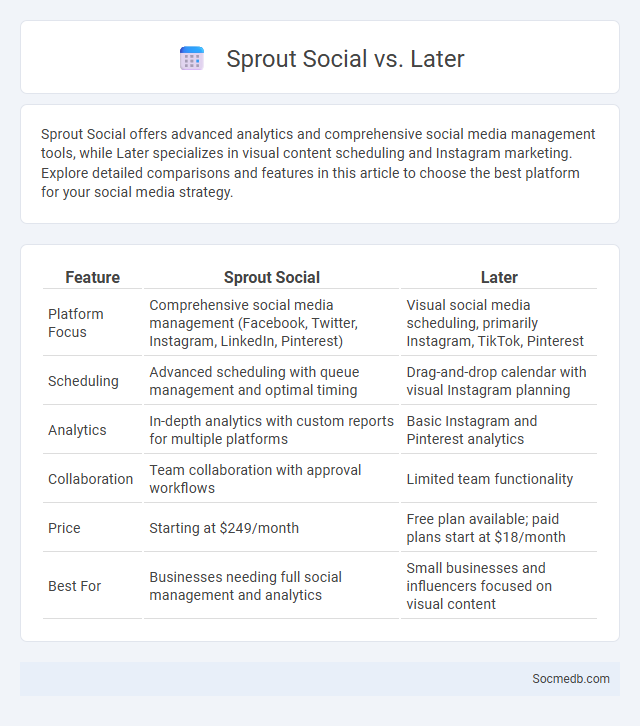
Photo illustration: Sprout Social vs Later
Sprout Social offers advanced analytics and comprehensive social media management tools, while Later specializes in visual content scheduling and Instagram marketing. Explore detailed comparisons and features in this article to choose the best platform for your social media strategy.
Table of Comparison
| Feature | Sprout Social | Later |
|---|---|---|
| Platform Focus | Comprehensive social media management (Facebook, Twitter, Instagram, LinkedIn, Pinterest) | Visual social media scheduling, primarily Instagram, TikTok, Pinterest |
| Scheduling | Advanced scheduling with queue management and optimal timing | Drag-and-drop calendar with visual Instagram planning |
| Analytics | In-depth analytics with custom reports for multiple platforms | Basic Instagram and Pinterest analytics |
| Collaboration | Team collaboration with approval workflows | Limited team functionality |
| Price | Starting at $249/month | Free plan available; paid plans start at $18/month |
| Best For | Businesses needing full social management and analytics | Small businesses and influencers focused on visual content |
Introduction to Social Media Management Tools
Social media management tools streamline content scheduling, analytics tracking, and audience engagement across multiple platforms, enhancing marketing efficiency. Popular tools like Hootsuite, Buffer, and Sprout Social provide comprehensive dashboards for real-time monitoring and performance insights. Leveraging these tools enables brands to optimize campaigns, track ROI, and maintain consistent online presence.
Overview: Sprout Social, Later, and Content Curation
Sprout Social offers robust social media management tools including analytics, scheduling, and engagement tracking to streamline Your brand's online presence. Later specializes in visual planning and scheduling, particularly for Instagram, enabling efficient content organization and posting. Content curation tools help discover and share relevant, timely content to boost audience engagement and maintain a consistent posting strategy.
Key Features Comparison
Social media platforms vary widely in key features such as content format, user interaction, and privacy settings. Visual-driven platforms like Instagram emphasize photo and video sharing, while Twitter prioritizes real-time text updates and trending topics. Understanding these differences helps you select the best platform for engaging your audience and achieving your communication goals.
User Interface and Workflow
An intuitive social media User Interface (UI) enhances your experience by simplifying navigation and minimizing clicks, enabling faster content discovery and interaction. Streamlined workflow features, such as customizable dashboards and integrated messaging, empower efficient multitasking and content management. Optimizing UI and workflow in social media platforms significantly boosts user engagement and productivity.
Content Scheduling Capabilities
Content scheduling capabilities in social media platforms allow users to plan, create, and automate posts across multiple channels efficiently. Tools like Hootsuite, Buffer, and Sprout Social enhance audience engagement by optimizing posting times based on analytics and user interaction data. This strategic approach maximizes reach and consistency, driving higher traffic and improving brand presence.
Content Curation Tools and Strategies
Content curation tools like Scoop.it, Feedly, and Pocket streamline the process of discovering, organizing, and sharing relevant social media content, enhancing audience engagement. Effective strategies include defining a clear niche, consistently sourcing high-quality material, and balancing curated content with original posts to build credibility. Leveraging analytics within these tools helps refine content choices, ensuring alignment with audience interests and maximizing reach.
Analytics and Reporting Functions
Social media analytics and reporting functions empower you to track engagement, reach, and audience demographics, providing actionable insights that optimize content strategy. Advanced tools offer real-time data visualization, trend analysis, and sentiment tracking to enhance decision-making and ROI measurement. Leveraging these features enables targeted campaigns that boost brand awareness and customer interaction effectively.
Pricing and Subscription Models
Social media platforms often employ freemium pricing models, offering basic features at no cost while charging for premium services such as advanced analytics, ad-free experiences, or exclusive content. Subscription models range from monthly to annual plans, with prices varying based on features, user base size, and platform reputation, exemplified by LinkedIn Premium and YouTube Premium. These strategies enable platforms to monetize user engagement while catering to diverse consumer needs and maximizing revenue streams.
Pros and Cons of Each Platform
Facebook offers extensive reach with over 2.9 billion monthly active users, making it ideal for brand awareness, but its algorithm changes can limit organic visibility. Instagram excels in visual marketing and engagement, particularly among younger demographics, though it struggles with issues of authenticity and mental health impact. Twitter provides real-time communication and trending topic access, yet faces challenges with misinformation and limited character space for detailed content.
Choosing the Best Tool for Your Business
Selecting the best social media tool for your business requires evaluating platforms based on your target audience, content type, and marketing goals. Tools like Hootsuite, Buffer, and Sprout Social offer comprehensive scheduling, analytics, and engagement features tailored to different business needs. You can maximize your social media impact by choosing a tool that aligns with your brand's strategy and customer interaction preferences.
 socmedb.com
socmedb.com